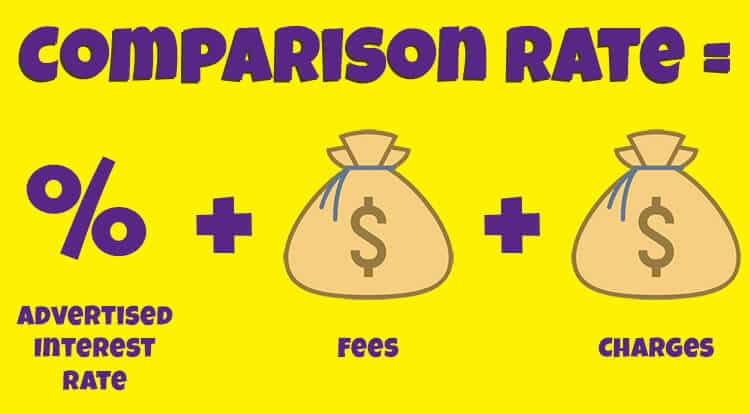Deciphering the full comparison rate home loan cost can be challenging, but it’s simpler when you understand the comparison rate. This figure combines the interest rate with fees to show the true cost of borrowing. Here we’ll explain the ins and outs of the comparison rate home loan, helping you make informed decisions without the financial jargon.
Key Takeaways
- The comparison rate offers a more inclusive figure of home loan costs than the interest rate alone, as it incorporates both the interest and additional fees, thereby providing borrowers with a clearer picture of the total cost of a loan.
- Financial institutions are legally required to calculate and display the comparison rate beside the advertised interest rate for transparency, and the rate includes standardised variables to ensure consistency – but it may not include all additional costs such as stamp duty and Lender’s Mortgage Insurance (LMI).
- While the comparison rate is a valuable tool for evaluating home loan offers, it’s important to consider other loan features and terms, along with personal financial needs and goals, to ensure the selection of a home loan that provides the best overall value and aligns with the borrower’s circumstances.
Decoding the Comparison Rate

Navigating the sea of home loan offerings can be quite an undertaking. The comparison rate serves as a key navigational tool in this process. This handy figure is more than just a number; it’s a legally mandated percentage that includes the interest rate and additional fees, providing a comprehensive view of a home loan’s cost. The comparison rate, in its role of providing transparency, shields borrowers from potential deception by low interest rates laden with concealed costs. It provides a more accurate reflection of the loan’s real cost implications than the bare interest rate, making it a vital tool in your home loan comparison toolkit.
However, don’t let the advertised home loan interest rate fool you; it’s the comparison rate that often reveals the higher overall cost. That’s because it accounts for fees, emphasising the importance of evaluating both rates when comparing loans.
Understanding the Home Loan Interest Rate
Before proceeding further, we need to grasp the concept of the home loan interest rate. This rate is the percentage charged on the principal loan amount to borrow money for a home. The initial portion of the mortgage payment is heavily weighted towards interest, especially in the early years of the loan. Higher interest rates result in larger mortgage payments, making them a critical factor in determining the short-term affordability and long-term cost of borrowing for a home loan.
Consequently, the home loan interest rate plays a significant role in your loan balance. Yet, it doesn’t give you the full picture of your home loan costs, as it excludes associated fees. That’s where the comparison rate steps in.
The Role of fees in the Comparison Rate
The comparison rate includes various fees such as:
- Monthly account fees
- Annual package fees
- Establishment fees
- Valuation fees
- Legal fees
- Settlement fees
These fees, which fall under the categories of upfront, ongoing, and discharge fees, significantly influence the formation of the comparison rate, including any applicable government fees.
For instance, application or establishment fees, charged at the beginning of the loan, are specifically included in the comparison rate calculation. Thus, the comparison rate provides a more comprehensive indication of the loan’s true cost than the advertised interest rate alone.
Distinguishing Between Interest Rates and Comparison Rates

Gaining insight into the distinction between interest rates and comparison rates can be highly informative. Here’s what you need to know:
- The interest rate is simply the charge on the borrowed amount.
- The comparison rate includes additional costs and fees to provide a more accurate representation of the true cost of the loan.
- Consequently, comparison rates are usually higher than interest rates as they encompass not only the interest rate but also additional charges including various fees.
Moreover, the comparison rate preempts lenders from advertising misleadingly low-interest rates that might ultimately lead to higher overall costs. Therefore, careful consideration of the comparison rate alongside the headline interest rate leads to an in-depth understanding of the actual cost of home loans.
How Is Your Home Loan Comparison Rate Calculated?

You may be curious about the exact method of calculating your home loan comparison rate. Well, lenders are legally required to calculate comparison rates using standardised variables such as the loan amount, term, and fees to ensure consistency and comparability. The calculation incorporates the interest payments based on the advertised interest rate, in addition to any fees associated with the loan.
Keep in mind that key loan variables such as the loan amount and the loan term can significantly impact the comparison rate. In general, discounts on larger loan amounts and longer terms usually lead to a higher comparison rate.
FirstPoint Mortgage Brokers Comparison Calculator
Variables Impacting the Calculation
Although standard comparison rates give a broad overview, they might not be indicative of individual financing needs as they typically consider a standard loan amount and term, such as $150,000 over 25 years. Therefore, selecting a suitable loan term is crucial. Shorter terms lead to higher repayments and less interest over time, while longer terms result in lower individual repayments but greater accrued interest.
Moreover, additional fees such as application, annual fees, and mortgage registration fees are integral to the comparison rate and can substantially raise it above the base interest rate.
Fortunately, home loan repayment calculators allow for custom inputs of loan amounts, terms, interest rates, and fees, aiding in a more tailored comparison of different home loans.
Navigating Variable Interest and Fixed Rate Options
The decision to opt for fixed or variable interest rates often involves striking a fine balance. Each has its pros and cons and understanding them is important for repayment predictability. Fixed rates provide stability by locking the interest rate for a predetermined period, offering protection against interest rate fluctuations and ensuring constant monthly repayments.
On the other hand, borrowers with variable interest-only loans and other variable-rate loans face fluctuating repayments that change in line with cash rate movements. A partially fixed rate or split loan combines the certainty of fixed rates on part of the loan with the flexibility of variable rates on the remainder.
To ensure an accurate comparison of loans, it is crucial to compare loans of the same type, which impacts the comparison rate and the total interest paid over the loan’s life, especially when it comes to home loans.
Additional Costs Not Reflected in the Comparison Rate

Despite the comparison rate providing a broad perspective on the loan’s cost, it doesn’t account for various costs like:
- stamp duty
- valuation fees
- legal fees
- Lender’s Mortgage Insurance (LMI)
These costs, along with account-keeping fees, early termination fees, and charges for optional features like offset accounts and redraw fees, are excluded from the comparison rate.
Not accounting for all additional costs can mislead borrowers about the true cost of a loan over its lifetime. Therefore, it’s essential to consider these expenses when evaluating home loan options.
Evaluating Home Loan Offers: Beyond the Comparison Rate
It is crucial to extend the evaluation of home loan offers beyond just the comparison rate. It does not reflect non-cost features such as flexible payment options, offset accounts, or fee-free banking services, all of which can be valuable depending on the borrower’s circumstances. As such, the evaluation of loan features like offset accounts or redraw facilities is crucial, despite potential higher costs.
Moreover, considerations such as the ability to make extra repayments or changes to the loan arrangement without high fees provide significant benefits to the borrower. Therefore, it’s crucial to compare not only the comparison rate but also other loan features and terms across multiple lenders to ensure the selected home loan meets the borrower’s needs and offers the best overall deal.
Making Sense of the Home Loan Market
Understanding the home loan market necessitates a fair amount of preliminary research. Aiming for the lowest interest rate possible is advisable, as it can save thousands over the life of the loan. Therefore, comparing various lenders’ rates is fundamental in this process. Additionally, investigating different loan options a lender offers ensures the chosen home loan aligns well with personal financial circumstances.
While introductory rates may initially be attractive, considering the long-term implications of an increased rate post-honeymoon period is critical for a sensible choice. Comparison websites are helpful tools for loan comparison, but it’s essential to recognise they may not include all available options and could display a bias towards advertised offerings. As such, mortgage brokers can aid in navigating the home loan market by aligning borrowers’ financial situations with suitable loan products.
Financial Institution Practices and the Comparison Rate
Are you aware that displaying the comparison rate is a mandated law for credit providers? They must display it alongside advertised interest rates, providing consumers with a comprehensive view of the loan’s cost. This practice was introduced by the Federal Government to standardise how home loan costs are presented, leading to increased market transparency.
A comparison rate must be given with details on how it was calculated and include warnings that the rate is only precise for the given example, ensuring consumers are aware of potential variances. Thus, financial institutions have a legal obligation to display the advertised comparison rate directly beside the advertised interest rate on home loan products.
The Influence of the Reserve Bank on Your Home Loan
The Reserve Bank of Australia (RBA) holds considerable influence over your home loan. It sets the cash rate, which is the benchmark interest rate for the overnight money market and influences consumer and business rates, including home loan rates. While the cash rate is different from mortgage interest rates, banks and lenders use it as a base to determine their lending interest rates, thereby directly affecting the home loan rates they offer.
When the RBA changes the cash rate, lenders often adjust their mortgage interest rates correspondingly. However, these changes may sometimes occur independently of the cash rate due to other factors such as market conditions or business strategies. Therefore, the affordability of home loans is directly tied to changes in the interest rate, where higher rates typically reduce the amount borrowers can afford and vice versa.
Personalising Your Home Loan Comparison
Although comparison rates offer a general overview, tailoring your home loan comparison can yield a more precise cost estimation. Standard comparison rates are based on set loan amounts and terms that may not reflect an individual’s unique circumstances. Therefore, creating a personalised comparison rate for one’s borrowing amount can offer a more accurate cost estimation than advertised rates. Realistic evaluations of borrowing capacity should account for possible interest rate increases to ensure long-term financial stability.
Selecting the right home loan features requires differentiating between essential ‘must-have’ features and optional ‘nice-to-have’ features based on personal lifestyle and needs. Key fact sheets are beneficial for personalising home loan comparisons, offering customised information such as the impact of interest rate changes on repayments.
Finally, it’s important to remember that personalizing your home loan comparison not only involves looking at the numbers but also understanding your lifestyle, future plans, and financial goals. After all, a home loan is not just about interest rates and fees; it’s about finding a financial solution that works for you.
Summary
In essence, the comparison rate is a crucial tool in evaluating home loan costs. It provides a more comprehensive view of the loan’s cost by including the interest rate and additional fees. However, it’s essential to consider all costs, even those not reflected in the comparison rate, and to understand the difference between interest rates and comparison rates. Being aware of the practices of financial institutions and the influence of the Reserve Bank can also be advantageous. Ultimately, personalising your home loan comparison and evaluating home loan offers beyond the comparison rate will help you secure a loan that best fits your financial needs.
Frequently Asked Questions
What is the comparison rate for a home loan?
A comparison rate for a home loan includes the interest rate as well as certain fees relating to the loan, helping identify the true cost and compare different loan options.
What does a 3.99% comparison rate mean?
A comparison rate of 3.99% includes the interest rate and additional fees, providing a more accurate representation of a loan’s true cost. It is a standard measure used to compare loans.
What is the difference between interest rate and comparable rate?
The interest rate reflects the percentage of the home loan that represents the interest, while the comparison rate includes the interest along with other fees and costs, providing a more comprehensive view of the loan’s true cost.
How is a comparison rate calculated?
A comparison rate is calculated by lenders using standardised variables such as the loan amount, term, and fees, which include interest payments based on the advertised interest rate and associated fees.












